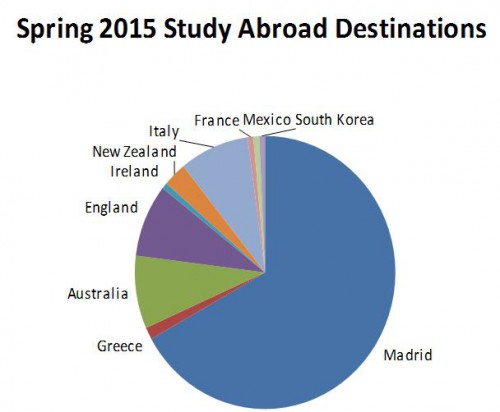With a campus in Madrid and one of the largest international student populations in Boston, Suffolk takes pride in offering a global experience to students. On campus in Boston, the diversity in languages and cultural student groups is evident. This experience is sometimes complemented with a semester studying abroad, a semester that is marketed as a an accessible opportunity by the study abroad office.
But what happens behind the scenes at our study abroad office to make this happen?
For one, establishing a campus in another continent requires financial adjustments. Tuition in Boston, set at $16,265 per semester for the 2014 – 2015 academic year, is almost $5,000 more than tuition in Madrid at $11,400.
“The logic behind it was the cost of living and not to be overly priced with the Madrid campus,” said Kathy Sparaco, director at international student services. “The purpose of having a campus there was to attract a European student population.”

While Suffolk offers study abroad opportunities in “every corner of the world,” as stated on its website, students tend to choose European cities above Asian or Latin American ones. One presumed reason by Sparaco for this is the language barrier, as most domestic students are only fluent in English.
Out of 139 students studying abroad this semester, 89 percent chose locations where English was the dominant language. Only 12 went to Italy, two to Greece, and one student went to each France, Mexico, and South Korea, according to data from the study abroad office.
“We have a pretty traditional study abroad population,” Sparaco said. “Traditional in the sense of where our students go. We do have populations to study [across the world], but generally our students are going to Spain, England, Italy, and Australia.”
Classes at the Madrid campus are taught in English.
Other factors that could influence where students study abroad are the availability of particular classes, semester dates, and cost.
While our study abroad office is busy advising students and sending them to universities abroad, other institutions in other countries are planning to send their own students to study at Suffolk’s Boston campus.
The challenge with this is what Sparaco called “balances.” Typically, both universities that exchange students aim to exchange an equal amount so as to even out tuition costs. While students are abroad at a foreign university, they continue paying their home university costs.
“When a student goes on a study abroad program, they pay Suffolk tuition,” Sparaco said. “When it’s an exchange program, let’s say Sophia University in Japan, you would go to Sophia but you’re paying for Suffolk. Likewise, the Sophia University student is paying Sophia tuition.”
The balance is examined after a three-year period.
“It doesn’t always work out that way,” Sparaco said. “But that’s what we would like to see.”













